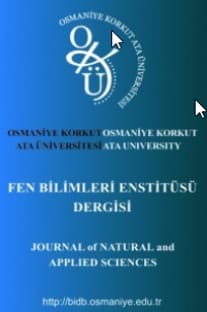Su Soğutmalı Fotovoltaik Sistemin Performans Analizi
Bu çalışma ile FV panellerin çalışma sıcaklıklarını harici soğutma düzenekleri ile azaltmak suretiyle verimliliklerinin artırılması Osmaniye yöresi için gerçeklenmiştir. Güneş enerjisinden elektrik üretirken panelin sıcaklığı artmakta ve bu da panel verimini azaltmaktadır. Fotovoltaik(FV) panelin ısısı, panelin arka yüzeyine yerleştirilen bakır plaka üzerine yerleştirilmiş bakır boru sistemi ile panel ısısının düşürülmesi böylelikle verimliliğin artırılması sağlanmıştır. Ayrıca, soğutmalı ve soğutmasız panel ısıl ve elektriksel verimliliklerinin Osmaniye bölgesi şartlarında karşılaştırılması yapılmıştır. Her iki panel için aynı anda güneş ışınımı, hava / FV panel sıcaklığı, güç, akım ve gerilim gibi FV panel karakteristik değerleri ölçülmüştür. FV panellerin termal ve elektriksel enerji performansı karşılaştırmalı olarak analiz edilmiştir. Genel verim için, su soğutmalı FV sisteminin % 5.9 ile soğutmasız FV panelinden daha iyi olduğu gözlenmiştir.
Performance Analysis of Water Cooled Photovoltaic Power Systems
The aim of this study consists of two stages. The first purpose is to increase the efficiency of photovoltaic (PV) panels by reducing their operating temperatures with external cooling devices to generate electricity from solar energy. The temperature of the photovoltaic panel (PV) is lowered by circulating water through the copper pipe system placed on the copper plate which is mounted on the rear surface of the panel, thus increasing the efficiency of the panel. The second objective is to compare the thermal and electrical efficiency of the refrigerated and normal panels under Osmaniye region conditions. PV panel characteristic values such as solar radiation, air/PV panel temperature, power, current and voltage were measured for both panels simultaneously. The thermal and electrical energy performance of PV panels was analyzed comparatively. For overall efficiency, it was observed that the water-cooled PV system was better than the normal PV panel with 5,9%.
___
- [1] Bahaidarah HMS., Gandhidasan P., Mahmood M. Performance evaluation of six configurations of a photovoltaic (PV) string with an integrated non-imaging concentrator and water cooling system, 2016 Ieee 43rd Photovoltaic Specialists Conference (Pvsc), 2016, p:844-846.
- [2] Ali AHH. Performance-cost and global warming assessments of two residential scale solar cooling systems versus a conventional one in hot arid areas, Sustainable Energy Technologies and Assessments 2017; 20: 1-8.
- [3] Fiducia TAM., Budhika GM., Kexue L., Chris RMG, Amit HM., Kurt B., Walajabad SS., Lewis DW., Ali A., Jake WB., John MW. Understanding the role of selenium in defect passivation for highly efficient selenium-alloyed cadmium telluride solar cells, Nature Energy 2019; 4(6): 504-511.
- [4] Bianchini A., Guzzini A., Pellegrini M., Saccani C. Photovoltaic/thermal (PV/T) solar system: Experimental measurements, performance analysis and economic assessment, Renewable Energy 2017; 111: 543-555.
- [5] Kumar P., Kumar A., Sudhakar SK., Mamat R. Experimental exergy analysis of water-cooled PV module, International Journal of Exergy 2017; 23(3): 197-209.
- [6] Uçman M., Fotovoltaik termal (FV/T) ve bina entegreli FV/T (BIPV/T) sistemlerde akışkan kullanımının elektriksel karakteristik üzerine etkisinin incelenmesi, Osmaniye Korkut Ata Üniversitesi Fen Bilimleri Enstitüsü ElektrikElektronik Mühendisliği Anabilim Dalı 2017; 111.
- [7] Erol H., Uçman M., Kesilmiş Z. Water cooled PV panel efficiency in Osmaniye environment, International Advanced Researches and Engineering Journal 2021; 5(1): 8-13.
- [8] Al-Nimr MA., Bukhari M., Mansour M. A combined CPV/T and ORC solar power generation system integrated with geothermal cooling and electrolyser/fuel cell storage unit, Energy 2017; 133: 513-524.
- [9] Bahaidarah H., Subhan A., Gandhidasan P., Rehman S. Performance evaluation of a PV (photovoltaic) module by back surface water cooling for hot climatic conditions, Energy 2013; 59: 445-453.
- [10] Baljit SSS., Chan HY., Sopian K. Review of building integrated applications of photovoltaic and solar thermal systems, Journal of Cleaner Production 2016; 137: 677-689.
- [11] Colt G. Performance evaluation of a PV panel by rear surface water active cooling. 2016 International Conference on Applied and Theoretical Electricity (Icate). 2016.
- [12] Matias CA., Santos LM., Alves AJ., Wesley PC. Electrical performance evaluation of PV panel through water cooling technique. 2016 Ieee 16th International Conference on Environment and Electrical Engineering (Eeeic). 2016.
- [13] Rajput UJ., Yang J. Comparison of heat sink and water type PV/T collector for polycrystalline photovoltaic panel cooling, Renewable Energy 2018; 116: 479-491.
- [14] Bai A., Popp J., Balogh P., Gabnai Z., Palyi B., Farkas I., Pinter G., Zsiborács H. Technical and economic effects of cooling of monocrystalline photovoltaic modules under Hungarian conditions, Renewable & Sustainable Energy Reviews 2016; 60: 1086-1099.
- [15] Abdel-Mesih BSA., Abdelrehim AA., Khobeiz AMH. Comparative analysis between water and nanofluids as working fluids in photovoltaic thermal collectors. Asme International Mechanical Engineering Congress and Exposition, 2014.
- [16] Ahmadi P., Dincer I., Rosen MA. Transient thermal performance assessment of a hybrid solar-fuel cell system in Toronto, Canada, International Journal of Hydrogen Energy 2015; 40(24): 7846-7854.
- [17] Aldossary A., Mahmoud S., Al-Dadah R. Technical feasibility study of passive and active cooling for concentrator PV in harsh environment, Applied Thermal Engineering 2016; 100: 490-500.
- [18] Kesilmiş Z., Erol H., Uçman M. Power optimization in partially shaded photovoltaic systems, Tehnički Glasnik 2018; 12: 34-38
- ISSN: 2687-3729
- Yayın Aralığı: Yılda 3 Sayı
- Başlangıç: 2017
- Yayıncı: Osmaniye Korkut Ata Üniversitesi
Sayıdaki Diğer Makaleler
Muhammad FARHAB, Muhammad Farhan IQBAL, Umar FAROOQ, Ayesha QADRY
Su Soğutmalı Fotovoltaik Sistemin Performans Analizi
Yatırıma En Uygun Restoran Alanlarının CBS ile Belirlenmesi, Tunceli Örneği
Selim TAŞKAYA, Neslişah ULUTAŞ
Muhammad FARHAB, Muhammad Farhan IQBAL, Umar FAROOQ, Ayesha QADRY
Etlik Piliçlerde Erken Dönem Besleme Uygulamaları
On Idempotency of Linear Combinations of Two 2×2 Idempotent Matrices
Ejder Meyvesinin Ozmotik Dehidrasyonu ve Kuruma Özelliklerinin Değerlendirilmesi
Endonezya'da Yetiştirilen Magnolia Cinsinin İyileştirilmesine Yönelik Biyoteknolojik Yaklaşımlar
